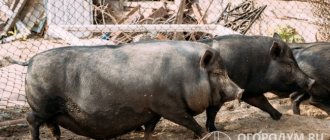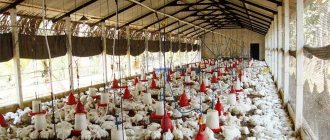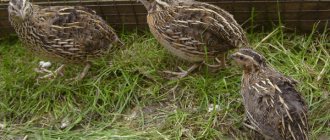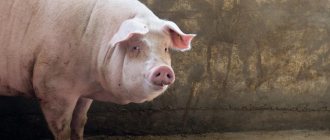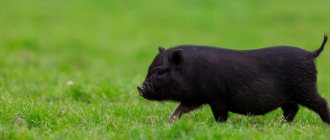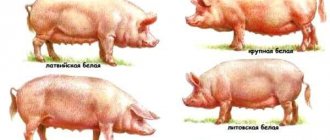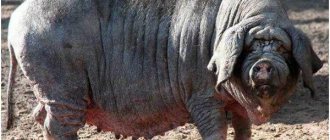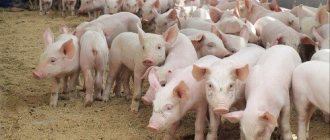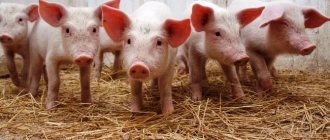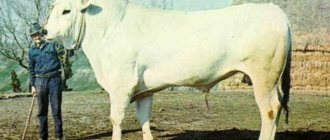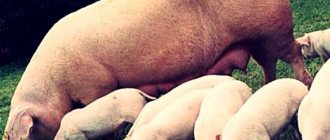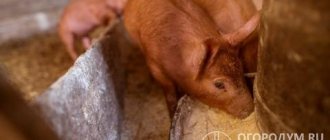Belarusian black-and-white breed of pigs
The Belarusian black-and-white breed of pigs belongs to the meat-fat (universal) direction of productivity. Pigs of this breed are well adapted to grazing, they are distinguished by a strong constitution, high fattening and meat qualities, and multiple births. The color is black and motley, sometimes there are pigs with red spots.
Pigs of the Belarusian black-and-white breed have a long and deep body, a light head with a straight profile and ears that hang slightly over the eyes. The back is wide, sometimes a little sagging, which is a disadvantage, the legs are strong and short. The hams are moderately developed. The weight of the ham is 10-10.3 kg, the thickness of the bacon is 33-36 mm. The weight of an adult boar is 300-340 kg, the weight of a sow is 220-240 kg. The multiple pregnancy of sows is 9-12 piglets per farrow. Milk production is average, on average about 60 kg. Piglets, as a rule, grow strong and healthy and reach a weight of 100 kg within six months. The average daily gain during control fattening is 700-750 g. Feed consumption per 1 kg of weight gain is 3.9-4 feed units.
The breed was bred on collective and state farms of the Byelorussian SSR in the process of long-term selection of local pigs. The Belarusian black-and-white breed of pigs appeared as a result of complex crossing of several other breeds with local livestock at the Belarusian Research Institute of Animal Husbandry. Initially, Belarusian Black and White pigs were used only locally, but over time they gained popularity in other regions.
Polesie pigs served as the basis for the creation of highly productive animals. The development of pig farming here was facilitated by high potato yields and the cultivation of rye, barley, wheat and other grain crops. Belarusian peasants willingly fattened pigs to fatty weight standards on potato and grain-potato diets using green feed, clover hay, pea chaff and other field waste. In the late 19th and early 20th centuries, Berkshire, Large White and Large Black pigs began to be imported to improve the local breed. As a result of unsystematic crossing and long-term selection, a large array of improved black-and-white early maturing pigs was created, well adapted to local conditions and characterized by high productivity when growing and fattening on potatoes. Active work with the breed began in the post-war years, highly productive herds were created, breeding farms and farms were organized, lines of boars and families of sows were bred.
The creation of new lines in the 60-70s was carried out through selection using the influx of blood from large white breeds of pigs and Landraces, strict selection of highly productive animals and strict culling of individuals with undesirable traits, evaluation of boars and dams based on the results of grading and the quality of offspring during control fattening . The Belarusian black-and-white pig breed was approved as an independent breed in 1975. Despite the high productive properties, breeding work with the Belarusian black-and-white pig breed has not yet been completed. Exterior deficiencies are being eliminated, ways are being sought to further improve the meat qualities and productivity of sows.
The advantages of the Belarusian black-and-white breed of pigs include their adaptability to pasture keeping, good prolificacy of sows (9-12 piglets per farrowing), piglets are usually born strong and healthy. Among the shortcomings, it should be noted such a common defect in the exterior as sagging back.
15.08.2012
Origin and registration
The breed owes its origin to the efforts of English farmers who, since the end of the 18th century, crossed local (“marching”) pigs with Mediterranean and South Chinese ones. From dissimilar crossbred animals, the most promising ones were selected for further selection, achieving sufficiently large but early maturing pigs.
The first who managed to achieve significant success in this direction was Joseph Tuley, who presented his Yorkshires at an exhibition in 1851, which had an impressive size and good meat shape. Since 1868, large Yorkshire dogs began to be called the Large White breed, and subsequently active work on its development and improvement was carried out exclusively through breeding methods (without interbreeding).
Large white breed sows on a modern livestock complex
Purebred individuals began to be imported into Russia from England in the mid-19th century. Now the breed is officially registered in the State Register of the Russian Federation (in 1993) as approved for cultivation in all regions of the country.
Feedback from livestock farmers
Matvey, 37 years old, Saratov
In my experience, the most unpretentious to feed, resistant to disease, early maturing, prolific and dairy breeds are our proven breeds - Large White and Soviet Meat (SM-1). Of course, buying purebred piglets is not easy or cheap. We took several KB from a private farm - clean, well-fed, active, with a good appetite. Each piglet (two months old) weighed more than 25 kilos. If you buy on the market, then you should not expect any guarantees of compliance with breed standards and vaccinations.
Ekaterina, 44 years old, Kuzbass
If I feed them a complete diet, I like white pigs (promki) the best. In 6 months they reached 100-110 kg live. And the Vietnamese (we have mini pigs) – 40-50 kg. At the same time, the whites ate about 400 kg each, and the Vietnamese 200 kg each. The choice depends on the purpose of raising pigs: for yourself, for sale or as a hobby.
Nikolay, 52 years old, Vinnytsia region
Now real lard is in great short supply, and there is a dominance of meat breeds all around. But I believe that any animal has meat, but only pigs have lard, which is why I like white ones. We specially feed grain and potatoes so that the lard becomes thick (in some places as big as 4 fingers), soft, tasty, whether for yourself or for sale - it goes in great demand.
Features of maintenance and feeding
Breeding Asian pigs should be organized by finding appropriate premises. The relatively small size of mature individuals makes it possible to place them in fairly small blocks.
Content
The pigsty can be equipped with brick, gas silicate blocks or wood.
"Vietnamese" do not need a spacious barn
It is advisable to concrete the floor, since a hard and smooth surface, without cracks, makes the cleaning process more efficient and less energy-consuming. In addition, pigs will not dig in the ground and make dirt. About 2/3 of the territory must be covered with wooden flooring, which will protect them from the cold in the winter. This will be the area reserved for the bedroom. Vietnamese pigs are characterized by rare neatness and cleanliness: they independently zone the space into a rest area and a toilet. A distinctive feature of the pigsties in which “Vietnamese” are bred is the absence of an unpleasant smell of feces.
Cages in a pigsty must have an area of at least 4.5 m²
A closed pigsty should be divided using metal partitions into separate blocks with an area of 4.5 - 5 m². Two mature individuals, a boar or a sow with piglets can freely live in one pen. The passage in the room should be wide enough so that the distance is enough for the unhindered movement of the cleaning cart.
We should not forget about the presence of a ventilation system: lack of fresh air has a negative impact on the health of pigs. An important point is heating: this breed, of course, is quite frost-resistant, but cold temperatures are contraindicated for females after giving birth.
Vietnamese pot-bellied pigs need to be walked daily during the warm season
For summer walking of animals, it is necessary to arrange a space at the rate of 1 hectare per 1 individual. Several logs with a non-uniform surface should be installed in the soil, on which animals can scratch their backs. It is also necessary to equip the walking area with a canopy that will protect the pigs from sunlight or rain. And don’t forget about mud baths: the “Vietnamese” love to spend time in such tanks. Mud helps animals remove blood-sucking insects from the surface of their bodies.
Vietnamese pig takes a mud bath
black pig
Today, farm owners raise pigs for different purposes. Someone simply strives to feed their family with natural homemade meat. Someone receives considerable income from the sale of pork and piglets for breeding. Moreover, if not so long ago the number of breeds bred in our country reached 5-6, today their diversity has increased to several dozen. And the black pig is of particular interest to breeders.
Black breeds of pigs
Based on eight different genotypes
The Belarusian meat breed appeared in the late 1990s.
The genes of eight breeds served as the material for its breeding. The breeders carried out intense and painstaking work using the methods of Russian specialists, who also worked hard on the meat representatives. For the first time, pigs that were very similar in both external and qualitative characteristics were crossed.
Distinctive features of the breed include a large litter at each farrowing (up to 12 piglets), high, as tastings show, meat and fat qualities, rapid growth (735-831 g every day), and resistance to infections.
Externally, Belarusian pigs look very large, muscular, with a developed rear part of the body. The head is relatively small, the back is slightly elongated. The skin is almost perfectly smooth and white.
Pig farming in Belarus
The increase in production volumes of livestock products, including pig breeding, in Belarus is proceeding more and more intensively. For our country, highly developed livestock farming has always been the basis for ensuring food security. Since this industry produces more than 65% of the value of gross agricultural output and the economic well-being of the majority of agricultural workers largely depends on its effective operation. organizations of the republic.
In the republic, all categories of farms produced about 7.0 million tons of milk and more than 1.8 million tons of meat (in live weight) in 2022. Per capita, 750,770 kg of milk and 120,130 kg of meat are produced annually.
The pig breeding industry is of decisive importance in the overall structure of livestock farming.
In the Republic of Belarus there are about 3.1 million pigs in all categories of farms, including 2.7 million in agricultural organizations, of which 390 thousand are in breeding farms.
Breeding is one of the main tasks
Over the past two decades, the pork industry in Belarus has generally functioned successfully. Unlike many countries of the former USSR, breeding centers for breeding animals have been preserved here and are currently actively developing. The country has research and zootechnical institutes engaged in hybrid activities and selection.
Recently, pigs bred on an interbreed basis (crossbreeds and hybrids) have been supplied to meat processing plants from the industrial sector. They are more adapted to production conditions and have better fattening and meat qualities. For this purpose, the world's best genotypes are taken.
Much work in pig farming is carried out to organize adequate feeding, develop requirements for the quality of feed and their components, and improve their structure.
Description of the breed
Photo 2
You can notice animals of this breed by their large build size with a well-developed rear (photo 1). This applies to both boars and sows.
The queens have twelve to fourteen large nipples, which are evenly spaced and have sharp outlines. Such distinctive features indicate multiple births (photo 2).
If we talk about the size of their head, it is not very large and quite light. The back is long and straight, the withers are level, the neck is of medium length. Pigs have muscular shoulders and rounded sides. The loin is slightly elongated, but level. The legs are positioned correctly and are strong. The skin is smooth and white. Boars have well-developed testes and strong bones. If we compare the Belarusian breed in terms of characteristic characteristics (for example, live weight) with other breeds, then in this case, undoubtedly, very strong arguments can be made in favor of the first. Completely different age categories have high rates.
Advantages and disadvantages
Despite the fact that dark breeds of pigs differ from each other, it is possible to identify common advantages and disadvantages of the group. The benefits of breeding black pigs include:
- High fertility. Most representatives of the group have a good ability to reproduce: sows give birth to an average of 9–11 cubs.
- Unpretentiousness. Black pigs are omnivores and are not capricious in matters of nutrition.
- Good adaptation. Almost all breeds tolerate summer heat and winter cold well.
- Rapid weight gain. Most pigs gain weight quickly and are of impressive size.
- Versatility. The animals produce a good yield of meat and fat and are suitable for breeding work.
Farmers consider the main disadvantages of black pigs to be the animals’ excessive appetite, which is why they often suffer from obesity. In addition, each breed has individual flaws: for example, large black pigs have a pampered constitution.
